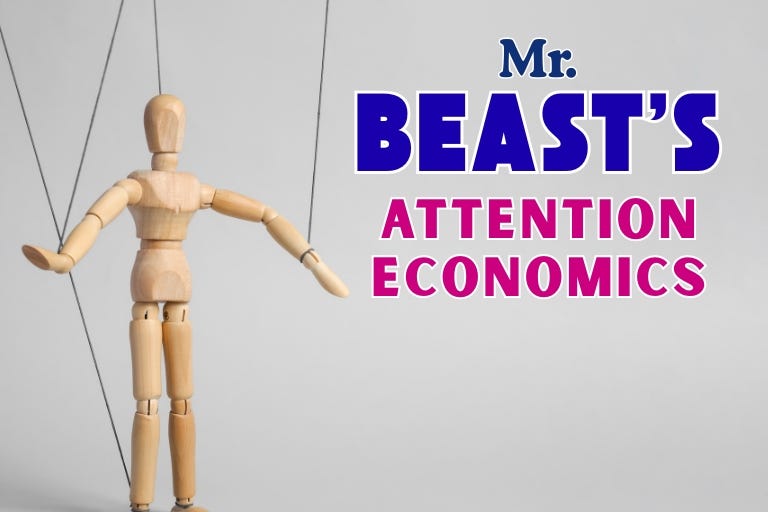What MrBeast's YouTube Empire Reveals About Attention Economics
Practical Steps For Applying His Principles
It’s not a stretch to say MrBeast gives away more money than some small countries' GDP while wearing the same hoodie in every video (he probably has a wardrobe full of the same ones).
He builds elaborate challenges that cost hundreds of thousands of dollars to produce.
Recreating Netflix shows with budgets that would make Hollywood executives weep.
And he treats YouTube videos like military operations requiring months of planning and teams of specialists.
Most people think he's just a generous guy with deep pockets making entertaining content.
They're missing the mathematical precision behind every decision he makes.
MrBeast has cracked the code of human attention and turned it into the world's most sophisticated content manufacturing system.
An Attention Investment Strategy
MrBeast doesn't spend money on videos.
It’s investing money in attention.
Every dollar given away, every elaborate set built, and every crazy stunt he orchestrates is calculated to generate maximum viewer engagement.
This is not being generous for the sake of generosity. It’s buying attention at scale.
When he spends $100,000 on a video that gets 50 million views, he's paying about $0.002 per viewer.
Traditional advertising costs exponentially more for far less engagement.
He's essentially created his own media company where the content budget is the marketing budget.
Emotional Engineering
MrBeast knows this better than most: attention follows emotion, and emotion follows surprise.
Thumbnails promise something your brain can't get past.
"$1 vs $100,000 Vacation!" "Last to Leave Circle Wins $100,000!" "I Gave My Credit Card to Random People!"
Forget catchy titles, they're psychological triggers designed to create what researchers call "curiosity gaps."
Your brain is bursting to find out what happens next.
Clickbait is a science in his mind, yet he delivers on every promise he makes.
The Art of Scale Psychology
Content creators tend to think small and hope to grow big. Not MrBeast he thinks impossibly big from the start.
Average YouTubers might give away $100.
MrBeast: $100,000.
Some creators might do challenges for an hour.
His challenges last for days.
The average videos use 2-3 people. You guessed it, he has dozens.
Psychologists call this "magnitude bias."
Our brains are wired to pay more attention to bigger numbers, larger groups, and more extreme scenarios.
He's exploiting cognitive biases that most people haven’t a clue even exist.
Reinvestment Machine
He has a self-sustaining attention economy where success funds bigger success.
Revenue from one viral video funds an even more expensive video. Brand deals enable larger giveaways. Higher production budgets create more engaging content, which generates more revenue.
It’s all self-perpetuating.
Generally creators plateau because they can't afford to scale.
MrBeast cleverly solves this by treating every video as an investment in his next video.
Team Specialization
He has teams focused entirely on thumbnail optimization.
Specialists who only work on video pacing.
Data analysts who study viewer retention by the second.
Logistics coordinators who manage the elaborate challenges.
Other YouTubers employ teams but nothing on the scale of this man.
He industrialized content creation before anyone else realized it was an industry.
His process doesn't follow trends. He creates entire content categories that other creators then copy.
Consistency Compound Effect
His team uploads videos with machine-like regularity. This consistency creates what psychologists call "habit formation" in his audience.
When you show up predictably, people start expecting you.
Expectation becomes anticipation.
Anticipation becomes loyalty.
And consistency beats intensity every time.
The person who writes for 30 minutes daily will outperform someone who writes for 8 hours once a month.
Your brain rewards predictable progress more than sporadic bursts of effort.
Building Your Personal Attention System
You don't need to be a MrBeast or have his budget to apply the same principles to your own life and goals.
Start by identifying what creates genuine value for the people you want to reach. Then systematically deliver that value with the same reliability MrBeast shows.
Track what works and what doesn't.
Most people guess their way through personal improvement.
Successful people measure their way through it.
Invest your successes back into bigger successes. Use small wins to fund bigger challenges.
Every achievement should make the next achievement more possible, not just more celebrated.
Focus Filter
MrBeast's content succeeds because it's designed around one clear objective: maximum engagement.
Apply this focus to your own projects.
What's your one primary objective?
Does this activity move you toward that goal or away from it?
Most people fail because they're trying to optimize for everything instead of excelling at something specific.
Extraordinary results come from extraordinary focus on what matters most.
What This Means for You
When you’re trying to build an audience, there are lessons to be learned by MrBeast’s approach.
Think investment, not expense.
Every piece of content should generate enough value to fund better content.
Scale creates attention.
Bigger, more surprising, more extreme gets noticed in a crowded landscape.
Specialize ruthlessly.
One person trying to do everything will lose to teams focused on specific elements.
Measure everything.
Data tells you what works better than intuition.
Create formats, don't just follow them. Being first to a new approach gives you massive advantages.
Most people still treat content creation like art.
MrBeast treats it like engineering. And his engineering approach is winning.


